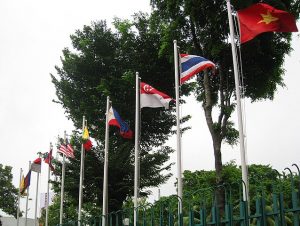On October 22, ASEAN and China kicked off the maritime field training component of the first-ever organized exercise between them, following the tabletop component that occurred in August. The engagement spotlighted an activity that holds wider significance within Beijing’s ongoing efforts at strengthening ties with Southeast Asian states, including in the security realm.
As I have noted before in these pages, while China had been officially and publicly proposing the holding of an ASEAN-China maritime exercise since 2015, the idea only really picked up steam in 2017 amid a confluence of events, including Beijing’s trumpeting of another temporary ‘cooling down’ period in the South China Sea after some recorded gains such as a warming Sino-Philippine relationship under Rodrigo Duterte. In June last year, at the Shangri-La Dialogue, Singapore’s Defense Minister Ng Eng Hen had confirmed that a first ASEAN-China maritime exercise would take place in 2018 under Singapore’s chairmanship of ASEAN (See: “What’s Behind the ASEAN-China Maritime Exercise?”).
This year, as scheduled, the tabletop component of the exercise took place at Singapore’s Changi Naval Base in August co-organized between Singapore and China. And this week, ASEAN and China kicked off the maritime field training component of the organized exercise between them in Zhanjiang in China’s southern Guangdong province.
The ASEAN-China maritime field training exercise, which began with an opening ceremony on October 22, is scheduled to last until October 28. It is set to feature several activities, including helicopter cross-desk landings and a joint search and rescue operation. While the exercise has been designated an ASEAN-wide exercise, in fact only five Southeast Asian countries have sent ships – Singapore, Brunei, the Philippines, Thailand, and Vietnam – while four others (Cambodia, Indonesia, Malaysia, and Myanmar) have sent observers.
Nonetheless, the exercise is not without significance. China has been keen to cast this as part of its ongoing effort to boost ties with Southeast Asian states on the security side. Indeed, just last week, the Chinese defense ministry had announced that China would also hold an exercise with both Thailand and Malaysia during the week of the maritime field training exercise – the first such engagement of its kind (See: “What’s in China’s Military Exercise with Malaysia and Thailand?”).
More broadly, Beijing has also highlighted this as its commitment to promoting regional stability, in spite of its continued actions in the maritime realm including in the South China Sea that are perceived to undermine it. In his remarks at the opening ceremony of the exercise, Chinese Vice-Admiral Yuan Yubai, the commander of the People Liberation Army Navy’s (PLA-N) Southern Theater Command, said he was confident the exercise would be a significant step in promoting a community of common destiny between China and ASEAN – a term Beijing has been using to emphasize the shared interests of both sides in spite of lingering challenges.
Interestingly, in his remarks, Yuan also spoke about the exercise as not just a one-off engagement, but an ongoing platform to build understanding between ASEAN and China. Moving forward, it will be interesting to see if such exercises do indeed become more of a norm between the two sides, and how Southeast Asian states and other outside actors like the United States will react in response as well.

































